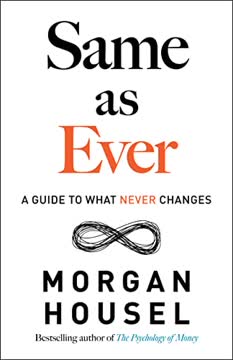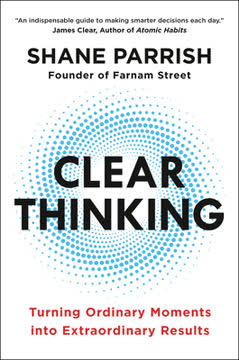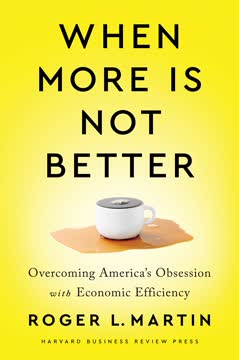Key Takeaways
1. Strategy and execution are inseparable; both involve making choices under uncertainty
Strategy is about revenue rather than cost, perfection is an impossible standard.
Strategy is about choices. The traditional view that strategy formulation and execution are separate processes is flawed. In reality, both involve making decisions under uncertainty and competitive pressure. Executives should focus on:
- Defining where to play and how to win
- Recognizing that strategy shortens the odds of success but doesn't guarantee it
- Making the logic behind choices explicit so they can be tested and refined
Rather than creating detailed plans, leaders should empower employees throughout the organization to make aligned choices within a clear strategic framework. This allows for faster adaptation as conditions change.
2. Customer loyalty is overrated; focus on creating cumulative advantage
Customers don't make conscious choices; they fall into habits.
Build habitual behavior. Traditional loyalty programs often fail because they ignore how people actually make decisions. Instead of trying to create loyal customers through rewards, companies should focus on:
- Becoming the easiest, most familiar choice
- Designing products and experiences that reinforce habits
- Maintaining consistency in branding, packaging, and user interfaces
The goal is to create a "cumulative advantage" where each interaction makes future interactions more likely. This is why category leaders like Tide detergent maintain dominant market share over long periods despite minimal product differences.
3. Corporate functions need their own strategies to add value
Corporate functions serve customers too: the business units that use their services.
Avoid the servile strategy. Many companies treat corporate functions like HR, IT, and finance as cost centers that simply support business units. This leads to undifferentiated, reactive service that fails to create value. Instead, functions should:
- Define their primary customers and core value proposition
- Determine what capabilities to build internally vs outsource
- Develop metrics to measure their impact on competitive advantage
By articulating a clear strategy, functions can focus on high-value activities, attract top talent, and avoid the threat of outsourcing. They become strategic partners rather than order-takers.
4. Organize knowledge work around projects, not permanent jobs
Knowledge work actually comes primarily in the form of projects, not routine daily tasks.
Embrace flow-to-work. Traditional job structures assume steady, predictable work, but knowledge workers face large swings in workload. To improve productivity:
- Organize around time-bound projects rather than permanent roles
- Create a pool of resources that can be allocated flexibly
- Develop systems to match skills with project needs
This approach, used successfully by consulting firms and Hollywood studios, reduces downtime and allows companies to tackle more high-value initiatives. It also creates opportunities for employees to develop new skills across multiple domains.
5. Culture change requires altering how individuals work together
You can only change it by altering how individuals work with one another.
Focus on interactions. Grand pronouncements about new values rarely change culture. Real transformation happens through small changes to daily work practices. Leaders should:
- Redesign meeting structures and communication norms
- Modify how decisions are made and resources allocated
- Create opportunities for cross-functional collaboration
These "micro-changes" gradually shift the unwritten rules that guide behavior. Over time, they create new shared assumptions about "how things are done around here."
6. Create great choices through imagination, not just data analysis
Creating great choices requires imagination more than data.
Balance analysis and creativity. Many executives overrely on data and analytics when making strategic choices. While rigorous analysis is important, breakthrough strategies often come from imaginative leaps. To generate novel options:
- Use qualitative research to uncover unarticulated customer needs
- Apply analogies from other industries or domains
- Create compelling narratives about future possibilities
The goal is to expand the set of choices beyond incremental improvements to the status quo. Data can then be used to test and refine the most promising ideas.
7. Intervention design is as critical as the innovation itself
The design of the intervention is as critical as the innovation itself.
Plan for adoption. Many potentially transformative innovations fail because not enough attention is paid to how they will be introduced and integrated. Successful intervention design involves:
- Mapping key stakeholders and their interests
- Prototyping and iterating on implementation approaches
- Creating narratives that build support and overcome resistance
By treating the rollout as carefully as the innovation itself, companies increase the odds that their ideas will take hold and create lasting impact.
8. In M&A, give value to get value
You need to give value to get value.
Focus on enhancing competitiveness. Most acquisitions fail because buyers focus on what they can get from the target company rather than what they can contribute. Successful acquirers:
- Identify specific ways they can make the target more competitive
- Avoid overpaying based on optimistic projections
- Invest in integration to realize synergies quickly
The goal should be to create a combined entity that is stronger than either company alone. This requires a clear understanding of each party's strengths and how they can be leveraged to create new sources of value.
Last updated:
FAQ
What's "A New Way To Think" about?
- Author and Purpose: "A New Way To Think" by Roger L. Martin is a guide to improving management effectiveness by challenging traditional business models and introducing new ways of thinking.
- Core Concept: The book argues that many existing management models are flawed and persist despite their ineffectiveness, and it offers alternative models that promise better outcomes.
- Structure: The book is divided into four parts, each focusing on different aspects of management: context, making choices, structuring work, and key activities.
- Target Audience: It is aimed at executives, managers, and anyone interested in enhancing their strategic thinking and management practices.
Why should I read "A New Way To Think"?
- Challenge Existing Models: The book encourages readers to question and rethink established management models that may not be delivering desired results.
- Practical Frameworks: It provides practical frameworks and alternative models that can be applied to real-world business challenges.
- Expert Insights: Written by a renowned management thinker, the book offers insights from Roger L. Martin's extensive experience advising top companies.
- Broad Applicability: The concepts are applicable across various industries and organizational levels, making it a valuable resource for a wide audience.
What are the key takeaways of "A New Way To Think"?
- Rethink Management Models: Many traditional management models are outdated and need to be replaced with more effective alternatives.
- Focus on Human Value: New ways of thinking should prioritize human value over organizational structures.
- Strategy and Execution: Strategy and execution are not separate; they are intertwined and should be treated as such.
- Customer-Centric Approach: To create shareholder value, businesses should focus on putting customers first.
What are the best quotes from "A New Way To Think" and what do they mean?
- Tom Peters on the Book: "I would pay 10 or 110 times the cover price for just the table of contents of this extraordinary book." This highlights the book's value in providing actionable insights.
- Julia Hartz on Simplification: "Roger Martin has an undeniable gift for simplifying the complex and nuanced scenarios of management." This emphasizes the book's ability to distill complex management issues into understandable concepts.
- Zhang Ruimin on Human Value: "New ways of thinking must shift from centering around the organization to centering around human value." This quote underscores the book's focus on prioritizing human-centric approaches in management.
How does Roger L. Martin suggest we rethink competition in "A New Way To Think"?
- Frontline Focus: Martin argues that competition happens at the front line, not at the head office, emphasizing the importance of customer interactions.
- Value Maximization: The book suggests that every corporate level should help the level below it to serve customers better, maximizing value at the front lines.
- Organizational Structure: It challenges traditional hierarchical structures, advocating for a more customer-centric approach that empowers frontline employees.
- Net Value Addition: Each organizational layer should add more value than it costs, ensuring competitiveness at the front line.
What does "A New Way To Think" say about stakeholder value?
- Customer First: The book argues that to create shareholder value, businesses should prioritize customers over shareholders.
- Long-Term Focus: It suggests that focusing on customer satisfaction leads to long-term shareholder value, as demonstrated by companies like Johnson & Johnson and Procter & Gamble.
- Compensation and Culture: The book discusses how compensation structures and corporate culture should align with a customer-first approach.
- Critique of Shareholder Primacy: It critiques the traditional focus on maximizing shareholder value, highlighting its limitations and potential for short-termism.
How does "A New Way To Think" address customer decision-making?
- Habit Over Loyalty: The book posits that customer decisions are often driven by habit rather than conscious loyalty, emphasizing the power of cumulative advantage.
- Ease of Choice: It suggests that offering customers the easiest choice, rather than the perfect one, can lead to sustained competitive advantage.
- Innovation and Familiarity: While innovation is important, maintaining familiarity and ease of use is crucial for customer retention.
- Behavioral Insights: The book draws on behavioral psychology to explain how processing fluency and repeated experiences influence customer preferences.
What is the "possibilities-based approach" in "A New Way To Think"?
- Strategic Possibilities: The approach involves generating multiple strategic possibilities and assessing what would have to be true for each to succeed.
- Testing and Choice: It emphasizes testing the conditions for success and making informed choices based on feasibility and potential outcomes.
- Collaborative Process: The approach encourages collaboration and input from diverse team members to generate creative and viable strategic options.
- Focus on Conditions: Instead of focusing on what is true, it asks what would have to be true, shifting the focus to potential and opportunity.
How does "A New Way To Think" redefine the role of data in decision-making?
- Imagination Over Data: The book argues that creating great choices requires imagination more than data, challenging the over-reliance on data-driven decisions.
- Possibility vs. Necessity: It distinguishes between situations dominated by possibility (changeable) and necessity (unchangeable), advocating for a design and imagination-driven approach in the former.
- Breaking the Frame: The book encourages breaking conventional frames and exploring new narratives to drive innovation and strategic thinking.
- Prototyping and Testing: It highlights the importance of prototyping and testing new ideas to create data and insights for decision-making.
What does "A New Way To Think" suggest about changing organizational culture?
- Indirect Change: The book emphasizes that culture can only be changed by altering how individuals work with each other, not by direct mandates.
- Interpersonal Mechanisms: It highlights the role of interpersonal interactions in aligning cultural and formal mechanisms within an organization.
- Microinterventions: Small changes in how meetings are structured and conversations are framed can lead to significant cultural shifts.
- Case Study: The book provides examples, such as the cultural transformation at the Rotman School of Management, to illustrate successful culture change.
How does "A New Way To Think" propose organizing knowledge work?
- Project-Based Organization: The book advocates for organizing knowledge work around projects rather than permanent jobs to improve productivity and flexibility.
- Flow-to-Work Model: It suggests a flow-to-work model where knowledge workers are assigned to projects based on demand, reducing downtime and inefficiencies.
- Knowledge Codification: The book emphasizes the importance of codifying knowledge to advance from heuristics to algorithms, enhancing knowledge transfer and productivity.
- Professional Services Model: It draws parallels with professional services firms, which successfully manage knowledge work through project-based structures.
What is the book's perspective on mergers and acquisitions (M&A)?
- Value Exchange: The book argues that successful M&A requires giving value to get value, focusing on what the acquirer can offer the target.
- Four Ways to Enhance Value: It outlines four ways to enhance an acquisition's competitiveness: smarter growth capital, better managerial oversight, skill transfer, and capability sharing.
- Avoiding the Take Mode: The book warns against acquisitions driven by a desire to enter attractive markets without understanding or enhancing the target's value.
- Perverse Incentives: It discusses the perverse incentives that drive M&A activity, such as stock-based compensation and accounting standards, leading to value-destroying deals.
Review Summary
A New Way to Think challenges traditional business models, offering fresh perspectives on strategy, talent management, and organizational structure. Readers appreciate Martin's insights but note some ideas aren't entirely novel. The book's format, compiled from HBR articles, receives mixed reactions. While some find it disjointed, others value its practical frameworks and thought-provoking concepts. Particularly praised are sections on strategy, M&A, and talent management. The book is seen as most relevant for executives and consultants in large corporations, though entrepreneurs also find value in its corporate insights.
Similar Books









Download PDF
Download EPUB
.epub digital book format is ideal for reading ebooks on phones, tablets, and e-readers.








